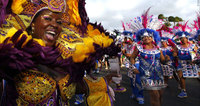Aruba carnival gets a golden touch in 2014

One of the biggest cultural events in the Dutch Caribbean island of Aruba takes on a golden touch in 2014 when its carnival extravaganza celebrates its 60th anniversary.
Aruba's carnival - or carnaval as it is known locally - is a months-long period of frenetic celebration including queen elections, road marches, tumba (a local music style with its origins in Africa but in its modern-day form influenced by meringue and Latin jazz) and calypso contests, parties and jump-ups, all leading to a dazzling Lighting Parade and Grand Parades in capital Oranjestad and the island's second city of San Nicolas.
Official carnaval season starts on November 11 at 11.11 am, running through to just before Lent but is at its height between January and March.
Enjoyed by young and old, with locals delighting in visitors also enjoying the free shows, carnaval is a mesmerising display of colour, creativity and local culture. 'Carnaval' is derived from the Latin carne vale, meaning farewell to flesh and referring to Lent. Its beginnings can be traced back to ancient feasts held to honour such gods as Bacchus and Saturn. Colonisation introduced the phenomenon to the New World and the French brought it to the Caribbean.
In Aruba, parades consist of 15 to 20 carnaval groups, each with its own theme reflected by their floats and extravagant costumes. Participants spend months on creating their glittery - and, often barely-there - costumes, some of which are so immense that their trails are put on wheels. Each group shimmies to the beat of its own band playing on a lorry moving with them and infusing the thousands of spectators along the route with their energy.
All 10th anniversaries of carnaval are extra spectacular and the 60th is expected to be particularly special. Locals save for months to create their costumes, often beginning after the end of the previous year's event and sometime foregoing their holiday to finance their costumes.
Next year the big finale parades in Oranjestad and San Nicolas are scheduled for March 1 and 2, so book your place now!
While carnaval is a highlight of the Aruban calendar, it's one of a number of local events reflecting the island's heritage and multi-cultural background. Even Christmas and New Year are infused with a special flavour. Aruba is, for example, the only island that has the dande, a tradition dating back to the 16th Century and influenced by the slaves in neighbouring islands. Groups of singers go from house to house, singing personalised songs of blessings for the New Year for each family, with words and rhythms passed down through the generations.
The dera gai (burial of the rooster) celebration takes place on June 24, the birthday of St John the Baptist, and marked with bonfires reminiscent of ancient pagan harvest celebrations. This cleaning of the countryside symbolised the ending of one planting season and the beginning of the new one, with ash helping to fertilise the ground. Originally, groups danced and played games around a rooster, buried with only its head showing but, happily, a more humane approach is taken today, with a gourd replacing the bird.
The island delights in many musical forms and currently the ting-a-ling box, a barrel organ first made on the island in 1938 is enjoying a resurgence, enthralling guests at parties and celebrations.
Arubans are great believers in natural medicine, with plants and herbs growing wild considered remedies for everything from baldness to diabetes, indigestion and impotence. Throughout the island, small shops known as botanicas stock herbs and scents that bring luck, success, love and good health.
The end of the year is seen as a time for cleansing and renewal and as Christmas approaches, houses are painted, cleaned and purified with incense and selected scents.
Another big date is January 25 when a national holiday commemorates the birth of the 'Liberator of Aruba', G. F. (Betico) Croes. This late political leader was the driving force behind Aruba's desire to separate from the Netherlands Antilles in 1986 and become an autonomous country within the Kingdom of The Netherlands. On this day Arubans gather - welcoming visitors to join - in Oranjestad's Plaza Betico Croes with a day-long programme, including a culinary festival, bazaar of local goods, a cultural show of Aruban folk dances, as well as carnaval music and dance.
The day is also the date for an island-wide Harley Davidson motorcycle tour, welcoming international riders, and two marathons held in Betico's home town of Santa Cruz.
For further information, visit aruba.com.

